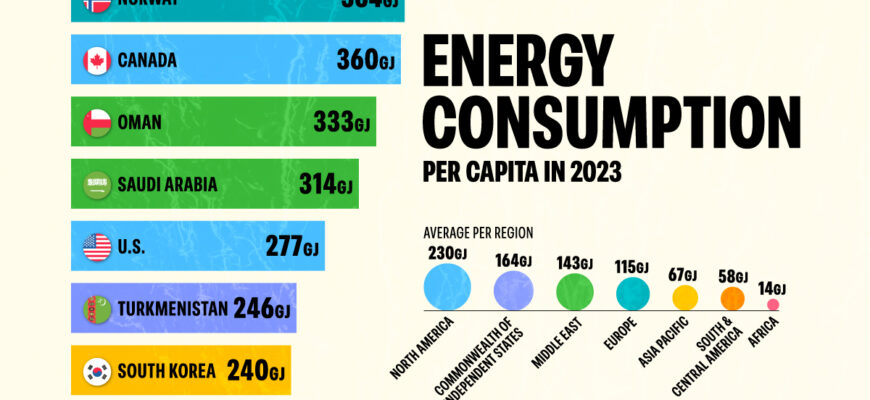If you think the richest countries automatically consume the most electricity per person, think again. That headline is only a part of the story. Per capita electricity consumption is shaped by climate, industry mix, household habits, public policy, and how much of an economy’s output comes from energy-intensive sectors. In this article we take the 10 largest economies in the world and rank them not by GDP, but by how many kilowatt-hours each person uses per year. The results reveal some expected leaders and some surprises, and they tell a bigger story about energy transition, economic structure, and where demand growth is likely to come from next.
- How we look at the problem
- Why per capita electricity consumption matters
- Top 10 largest economies ranked by per capita electricity consumption
- What the ranking tells us
- Factors that push per capita consumption up
- Factors that push it down
- Why some surprises make sense
- The growth story: where demand is headed
- Policy levers that matter
- How to read these numbers in context
- Practical takeaways for readers
- Conclusion
How we look at the problem
First, a quick note on method and scope. “Largest economies” here means the top 10 by nominal GDP (United States, China, Japan, Germany, India, United Kingdom, France, Canada, Italy, Brazil). For per capita electricity consumption we use recent, publicly reported figures (from agencies like the International Energy Agency and World Bank) as general benchmarks — reported values vary slightly depending on year and source, so think of the numbers here as representative averages for the most recent years available. The intent is to show relative order and to explain the drivers behind those differences.
Why per capita electricity consumption matters
Per capita electricity consumption gives a window into how modern a society’s infrastructure is, how energy-intensive its industry is, and how lifestyle factors (heating and cooling, appliance use, electric vehicles, digital services, etc.) add up to national demand. Two countries with similar GDPs can have very different electricity footprints because one might be more industrialized or colder, while the other might be service-oriented or more energy-efficient. Policymakers use these figures to plan grid investments, decarbonization pathways, and to anticipate load growth from electrification of transport and heating.
Top 10 largest economies ranked by per capita electricity consumption
Below is a ranked table showing the top 10 economies by nominal GDP and ordering them by their approximate electricity consumption per person (kWh per year). Numbers are rounded and approximate, intended to illustrate the order and scale rather than precise current-year totals.
| Rank by Electricity per Capita | Country (GDP Rank) | Approx. Electricity per Capita (kWh/year) | Notes |
|---|---|---|---|
| 1 | Canada (8) | ~15,000 | Cold climate, large hydro sector, energy-intensive extraction industries. |
| 2 | United States (1) | ~12,000 | High household and industrial electricity use, wide vehicle electrification potential. |
| 3 | Japan (3) | ~8,000 | Industry and high standards of living drive steady demand; compact urban use patterns. |
| 4 | Germany (4) | ~7,000 | Manufacturing economy with strong efficiency policies and rising renewables. |
| 5 | France (7) | ~7,000 | Nuclear-heavy mix gives reliable baseload and relatively high per capita use. |
| 6 | Italy (9) | ~5,000 | Moderate industrial demand, milder climate reduces heating load but air conditioning increases summer use. |
| 7 | United Kingdom (6) | ~4,500 | Service-oriented economy with strong energy efficiency measures, but rising electrification expected. |
| 8 | China (2) | ~4,500 | Large population and heavy industry — aggregate consumption enormous, per person still mid-range. |
| 9 | Brazil (10) | ~2,500 | Tropical climate reduces heating demand; hydro is dominant but electrification gaps remain in some regions. |
| 10 | India (5) | ~1,200 | Rapidly growing demand but low current per capita use due to lower electrification rates and lower appliance ownership. |
What the ranking tells us
Several clear patterns emerge. Wealthier, colder, or resource-rich countries tend to appear higher in per capita consumption — Canada and the United States lead the list among these top economies. Industrial structure matters: economies with heavy industry, mining, or chemical production often have higher per-person electricity use because a small share of industry can consume a lot of power. Conversely, large emerging economies with massive populations, like India and China, can have huge total consumption but relatively low per capita use — China sits mid-table and India is near the bottom despite rapid growth.
Factors that push per capita consumption up
- Cold weather and heating needs (higher across North America and parts of northern Europe).
- Energy-intensive industries: aluminium, chemicals, steel, and data centers.
- High appliance and vehicle ownership — especially when electric.
- Extensive, reliable electricity infrastructure that encourages use.
Factors that push it down
- Service-heavy economies with lower industrial electricity intensity.
- Lower electrification and income levels limiting appliance ownership.
- Energy efficiency measures, building standards, and conservation policies.
- Mild climates reducing heating or cooling loads.
Why some surprises make sense
You might be surprised France ranks relatively high despite a smaller population than its peers. The country’s heavy reliance on nuclear power provides abundant, low-carbon baseload electricity, encouraging more usage per person than you might expect from a European country. Japan and Germany, both with significant industrial bases and high living standards, cluster in the solidly above-average range. China’s per capita figure has been climbing as the country urbanizes and industry modernizes, but the scale of its population keeps per-person numbers modest compared with North America.
The growth story: where demand is headed
The transition to electric vehicles, heat pumps, and expanded digital infrastructure (cloud computing, AI, data centers) tilts the future toward higher per capita consumption in many countries — even as energy efficiency offsets some of that growth. For example, the United Kingdom and many EU countries may see sharper increases as household heating shifts from gas to electricity, whereas countries like India will register rapid per capita growth as more homes get reliable services and incomes rise.
Policy levers that matter
- Grid investments to handle higher peak loads and distributed generation.
- Incentives for rooftop solar and storage to shift demand and reduce peak stress.
- Efficiency standards for appliances, buildings, and industry to manage long-term consumption.
- Electrification subsidies and infrastructure for transport to guide where and how load grows.
How to read these numbers in context
Per capita electricity consumption is a useful snapshot, but it isn’t the whole story. Two nations with similar per capita kWh can be on very different energy trajectories: one may be decarbonizing via renewables while reducing industrial use, and another may be increasing fossil fuel generation to meet rising demand. Also, temporary events — cold winters, heatwaves, economic slowdowns, or supply disruptions — can cause year-to-year swings.
When you plan for the future — as a policymaker, utility planner, or investor — you want to overlay these consumption patterns with generation mix, emissions goals, and expected changes like electric vehicle adoption rates. For instance, a country with high per capita consumption and a large share of renewables may have a different investment need than a similarly consuming country heavily dependent on coal.
Practical takeaways for readers
If you’re curious about energy use at home, start by checking how much electricity your household consumes and what the major drivers are — heating, cooling, hot water, appliances, or an EV. For those interested in the macro picture: countries with high per capita consumption are likely to be early adopters of new grid technologies, battery storage, and demand-side management solutions. Countries with low per capita use represent both an opportunity and responsibility: they will see some of the fastest relative increases in consumption as living standards rise, which is a major consideration for global energy and climate policy.
Conclusion
Ranking the world’s largest economies by per capita electricity consumption cuts through the noise of big numbers and reveals how climate, industry, policy, and social choices shape energy demand. Canada and the United States lead among the top economies, Japan, Germany, and France sit in the mid-to-high range, and large-population countries like India and China show the growth potential behind lower current per-person use. As the world electrifies further — with EVs, heat pumps, and a growing digital economy — these rankings will shift, but the underlying lesson remains: per capita electricity tells us where infrastructure, policy, and investment will matter most in the transition to a cleaner, more electric future.
Interested in more deep dives like this? Visit https://themors.com/ to explore more articles, data-driven analyses, and guides about energy trends, economics, and the technologies shaping our world.









